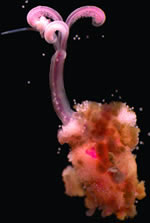Discovery of North Sea marine worm
A new species of marine worm called Osedax mucofloris (which means bone-eating snot-flower) was found in 2004 in one of the best-studied marine environments on the planet, the shallow water environment of the North Sea.
Have a look at the worm in the video above, made by the scientists who discovered it.

Photomicrograph of Osedax mucofloris
Scientists from the Natural History Museum and Göteborg University in Sweden discovered a large colony of the worm growing on the bones of a minke whale in the North Sea.
'We were astounded to discover a species completely new to science in an environment that is so well known,' said Adrian Glover, marine biologist at the Museum.
Studying the marine environment
In October 2003, Adrian and Thomas Dahlgren sank the remains of a dead, stranded minke whale and then studied the fauna living on the decomposing carcass. In August 2004 the scientists studied a bone from the carcass and were surprised to find a species of marine worm (Osedax) that had previously been thought to exist only in a deep-sea environment.
Glover and Dahlgren compared the worms with similar 'zombie worm' species that scientists from Monterey Bay Aquarium Research Institute recovered from a deep-sea 'whale-fall' (the disintegrated carcass of a whale) off the coast of California.
There are remarkable similarities between the two worm species, despite being separated by two ocean basins and 2,500m of water depth. All of the Osedax species found so far appear to be closely related to the vestimentiferan tubeworms, which are known only from undersea volcanoes called hydrothermal vents. One theory is that whale-falls may be used as a type of 'stepping-stone' for deep-sea creatures to disperse throughout the oceans.
Toolbox

In World War II the Museum was used as a secret base to develop new gadgets for allied spies, including an exploding rat!